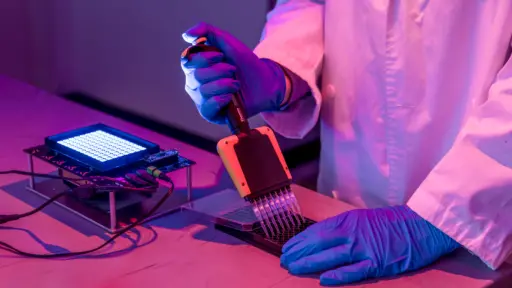When a cell contends with changes in its environment, it takes action to respond. Signals travel through its internal circuitry, turning various cellular machinery on and off, expressing some genes while repressing others.
One class of proteins—transcription factors, which bind DNA and regulate gene expression—plays a key role in enabling responses tailored to each stress.
Now, biomedical engineering researchers at the University of Wisconsin-Madison have uncovered a more nuanced understanding of how cells use those transcription factors to transmit different signals and alter gene expression. They describe their findings in a paper published in the journal Cell Reports.
“Cells can actually encode information in how these transcription factors turn on and off over time, and the genes themselves are capable of decoding this information in order to respond appropriately to different stresses,” says Kieran Sweeney (PhDBME ’22), who led the work and is now a postdoctoral researcher in Associate Professor Megan McClean’s lab.
 Associate Professor Megan McClean
Associate Professor Megan McClean
In order to fulfill their job in this intracellular game of telephone, transcription factors juggle messages from multiple signaling pathways, which converge on them in a bowtie pattern. So how exactly does one transcription factor relay all that information?
To answer that question, Sweeney employed light-controlled mutants of the transcription factor Msn2 in yeast (part of the optogenetic toolkit McClean’s research group has created to study biological signal processing), in tandem with high-throughput microscopy and computational modeling.
His work bolsters previous evidence of the downstream effects of transcription factors’ movement in and out of the cell’s nucleus, the duration of their stay (think Morse code) and pulsing behavior, all of which Sweeney controlled with light. Importantly, he also characterized how manipulating the proteins’ ability to bind DNA affects the signal decoding behavior of downstream genes. As McClean puts it, that’s essentially discovering additional knobs for tuning a signal.
“It means you don’t need a different transcription factor to respond to each signal,” says Sweeney, who calls Madison home after growing up in Waterford, Ireland, and attending high school in New London, Wisconsin. “You can take your components and reuse them for different situations. For cells, it’s probably a way to make the best use of what they have.”
While fundamental in nature, the research could have implications for the mechanics of two key transcription factors in humans: NF-kappaB, which is involved in wound healing, and p53, which suppresses cancer tumor growth. It’s also relevant to synthetic bioengineering applications, such as ethanol production. McClean’s lab is already pursuing projects employing its light-controlled method with synthetic transcription factors, examining the signaling capabilities of other transcription factors in yeast, and exploring optogenetic possibilities in stem cells.
Undergraduate students in the Department of Biomedical Engineering’s design curriculum are also working on new optogenetic instrumentation, under the direction of Associate Teaching Professor Amit Nimunkar, who worked with Edvard Grødem, a visiting student from Norway via the Brittingham Viking Organization at UW-Madison, to build the lab’s optoPlates for illuminating well plates.
“It was one of those instances where being in an engineering environment was really useful for developing the tech,” says McClean. “It’s this really fundamental idea of how cells communicate information. We know they don’t have enough pieces where A goes to A, B goes to B, C goes to C, infinitely. Kieran uncovered this pretty important piece of the puzzle, and it required this tour de force of bioengineering and instrumentation to be able to even do the experiment.”

The research was funded by the National Institutes of Health (grant R35GM128873), the National Science Foundation (grant 2045494) and the University of Wisconsin Carbone Cancer Center (Support Grant P30 CA014520).
Top photo caption: Postdoctoral researcher Kieran Sweeney used a combination of bioengineered, light-controlled transcription factors, high-throughput microscopy and computational modeling to elucidate signal processing behavior in yeast cells. Photo: Joel Hallberg.